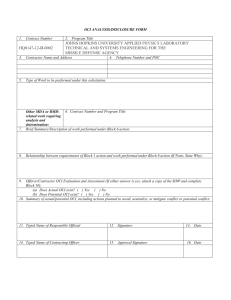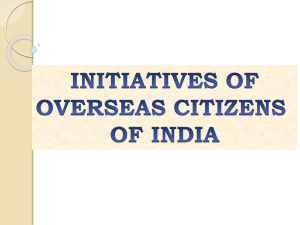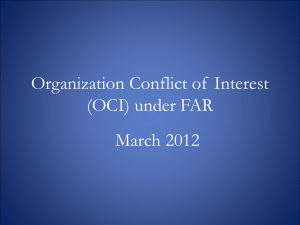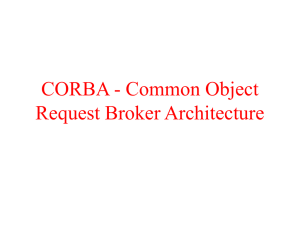Here - Academic Csuohio
advertisement
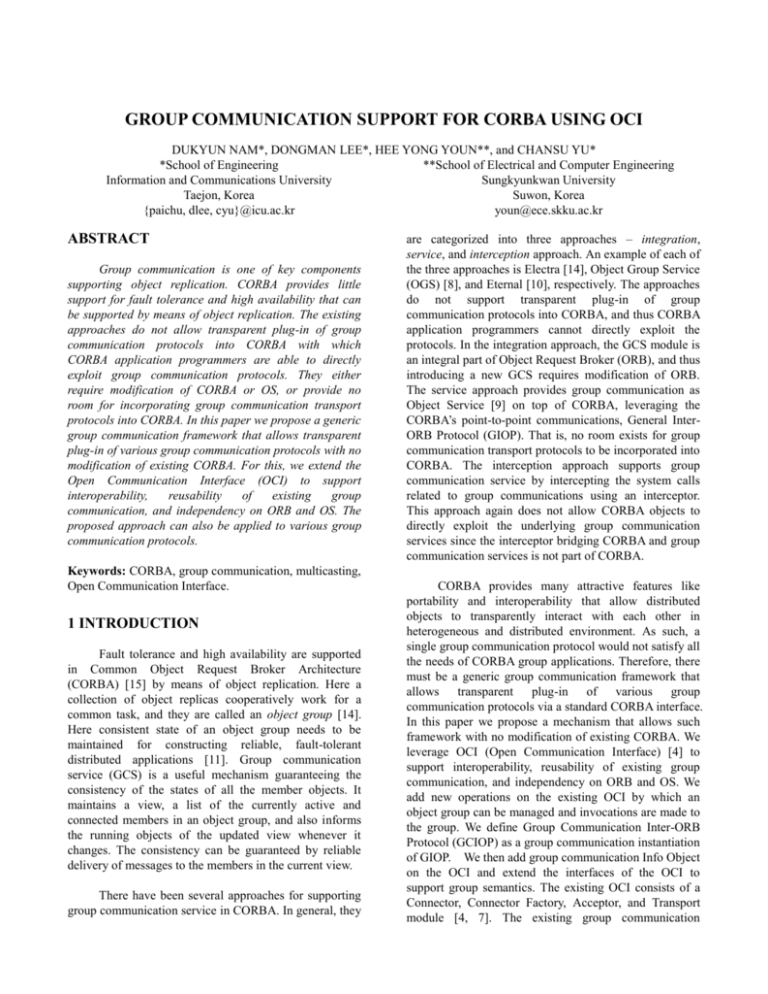
GROUP COMMUNICATION SUPPORT FOR CORBA USING OCI
DUKYUN NAM*, DONGMAN LEE*, HEE YONG YOUN**, and CHANSU YU*
*School of Engineering
**School of Electrical and Computer Engineering
Information and Communications University
Sungkyunkwan University
Taejon, Korea
Suwon, Korea
{paichu, dlee, cyu}@icu.ac.kr
youn@ece.skku.ac.kr
ABSTRACT
Group communication is one of key components
supporting object replication. CORBA provides little
support for fault tolerance and high availability that can
be supported by means of object replication. The existing
approaches do not allow transparent plug-in of group
communication protocols into CORBA with which
CORBA application programmers are able to directly
exploit group communication protocols. They either
require modification of CORBA or OS, or provide no
room for incorporating group communication transport
protocols into CORBA. In this paper we propose a generic
group communication framework that allows transparent
plug-in of various group communication protocols with no
modification of existing CORBA. For this, we extend the
Open Communication Interface (OCI) to support
interoperability,
reusability
of
existing
group
communication, and independency on ORB and OS. The
proposed approach can also be applied to various group
communication protocols.
Keywords: CORBA, group communication, multicasting,
Open Communication Interface.
1 INTRODUCTION
Fault tolerance and high availability are supported
in Common Object Request Broker Architecture
(CORBA) [15] by means of object replication. Here a
collection of object replicas cooperatively work for a
common task, and they are called an object group [14].
Here consistent state of an object group needs to be
maintained for constructing reliable, fault-tolerant
distributed applications [11]. Group communication
service (GCS) is a useful mechanism guaranteeing the
consistency of the states of all the member objects. It
maintains a view, a list of the currently active and
connected members in an object group, and also informs
the running objects of the updated view whenever it
changes. The consistency can be guaranteed by reliable
delivery of messages to the members in the current view.
There have been several approaches for supporting
group communication service in CORBA. In general, they
are categorized into three approaches – integration,
service, and interception approach. An example of each of
the three approaches is Electra [14], Object Group Service
(OGS) [8], and Eternal [10], respectively. The approaches
do not support transparent plug-in of group
communication protocols into CORBA, and thus CORBA
application programmers cannot directly exploit the
protocols. In the integration approach, the GCS module is
an integral part of Object Request Broker (ORB), and thus
introducing a new GCS requires modification of ORB.
The service approach provides group communication as
Object Service [9] on top of CORBA, leveraging the
CORBA’s point-to-point communications, General InterORB Protocol (GIOP). That is, no room exists for group
communication transport protocols to be incorporated into
CORBA. The interception approach supports group
communication service by intercepting the system calls
related to group communications using an interceptor.
This approach again does not allow CORBA objects to
directly exploit the underlying group communication
services since the interceptor bridging CORBA and group
communication services is not part of CORBA.
CORBA provides many attractive features like
portability and interoperability that allow distributed
objects to transparently interact with each other in
heterogeneous and distributed environment. As such, a
single group communication protocol would not satisfy all
the needs of CORBA group applications. Therefore, there
must be a generic group communication framework that
allows transparent plug-in of various group
communication protocols via a standard CORBA interface.
In this paper we propose a mechanism that allows such
framework with no modification of existing CORBA. We
leverage OCI (Open Communication Interface) [4] to
support interoperability, reusability of existing group
communication, and independency on ORB and OS. We
add new operations on the existing OCI by which an
object group can be managed and invocations are made to
the group. We define Group Communication Inter-ORB
Protocol (GCIOP) as a group communication instantiation
of GIOP. We then add group communication Info Object
on the OCI and extend the interfaces of the OCI to
support group semantics. The existing OCI consists of a
Connector, Connector Factory, Acceptor, and Transport
module [4, 7]. The existing group communication
basically requires group address expansion, delivery
ordering, and state transfer [5]. To satisfy these
requirements of group communication, a group name,
ordering type, and state are saved in the Info object. We
add an attribute to Connector’s Transport Info for setting
the ordering-type and add group maintenance operations
to Acceptor. The proposed design can be applied to
various group communication protocols without any
modification of ORB and the OCI.
The reminder of the paper is structured as follows.
Section 2 discusses the existing approaches for group
communication in CORBA. Section 3 describes the
proposed extension to OCI for group communication, and
Section 4 presents how OCI group communication
extension is used with applications. In Section 5,
implementation of the proposed structure is described.
Discussion and conclusion follow in Section 6.
2 RELATED WORK
In this section, we describe the existing approaches
supporting group communication service for CORBA.
Electra [14] integrates group communication service with
CORBA by extending Basic Object Adapter (BOA). The
group membership relies on underlying group
communication systems. Here, in order to support object
group abstraction, group reference is specifically designed.
Users can set call semantics such as synchronous call,
asynchronous call, and deferred synchronous call using
ORB Environment class. The implementation and
performance of the system are efficient since there is no
intermediate object between ORB and group
communication system. However, this approach needs to
modify ORB for creating group reference and supporting
group communication.
Object Group Service (OGS) [8] designs new
CORBA Object Service for group communication. OGS
consists
of
three
components:
Groupable,
GroupAdministrator, and GroupAccessor. Groupable
has interfaces for message receive, group composition
notification, and state transfer operation, which are used
by the member objects. GroupAdministrator has
interfaces for group operations, which are join_group and
leave_group. GroupAccessor has interfaces related to
multicast operation [9]. In this case, group view exists in
the service itself. Also message multicast is supported by
using a proprietary messaging service. This approach is
independent from ORB and guarantees portability with
CORBA Object Service. However, it cannot utilize
existing group communication system and has potential
drawback on the performance.
Eternal [10] and Eternal interceptor [11] capture
and transmit the Internet Inter-ORB Protocol (IIOP)
message to the replication manager, which maps messages
onto the group communication system. Especially, the
join/leave group and send/receive operation are mapped to
open/close and write/read system call, respectively. Here a
unique object group identifier is associated with each
interface name. The mapping table containing group
identifier and interface name is maintained by replication
manager, which is globally accessible [10]. Message
multicast occurs using underlying group communication
system. This approach need not modify ORB as in the
case of using interceptor. However, it is dependent on the
OS since interceptor is implemented in the system call
level.
Halteren, et al. [1] applied IP Multicast to CORBA
by extending the OCI [4]. The OCI provides open
interfaces that can substitute TCP/IP in CORBA. It
implements the Acceptor/Connector module [2] in ORB.
The module distinguishes connection establishment from
service initialization occurring in the communication of a
client/server model. The OCI consists of an acceptor (at
server side) and a connector (at client side) for connection
establishment, and a transport as a communication
component. In order to meet the requirements on transport
layer such as connection-oriented, reliable data transport,
transported data as a stream, and notification of
connection loss in the CORBA specification [15], they
added the schemes for acknowledgement and
retransmission of packets to the intermediate protocol.
They also used modified Interoperable Object Reference
(IOR) that includes IP multicast address (D class) and a
sequence number. However, their approach does not
provide a generic framework that can accommodate
various group communication protocols in CORBA.
Moreover, dynamic group membership is not supported
because Java IP Multicast API is directly used as group
operations.
Multicast Group Internet Inter-ORB Protocol
(MGIOP) engine was designed with MGIOP specification
in [6]. MGIOP consists of group ID and domain ID.
Especially, it does not instantiate GIOP but encapsulate
GIOP message itself. The MGIOP engine concurrently
supports different group communication protocols. It also
requires modification of ORB because its engine must be
included in ORB or connected to it. We next present the
proposed mechanism for group communication.
3 THE PROPOSED MECHANISM FOR
GROUP COMMUNICATION
In this section, we first describe the overview of
OCI and how a given transport protocol is integrated into
it. We then present the proposed extension to OCI for
group communication including the IDL specification of
the extended OCI.
3.1 COMMUNICATION USING OCI
OCI provides plug-in protocol interfaces for
CORBA. The interfaces are Buffer, Acceptor, Transport,
Connector, Connector Factory, Registries, and Info
objects [7]. A Buffer holds data in an array of octets and
maintains a position counter, which are used in
communications between a client and server. Info objects
provide information on Acceptor, Transport, Connector,
and Connector Factory. Figure 1 shows how OCI
incorporates a given transport protocol with ORB. As a
client and server are activated, an Acceptor Registry in the
Object Adapter (OA) activates an Acceptor, and a
Connector Factory Registry in ORB creates a Connector
Factory. Then at the server side, an Acceptor creates
profile information for an Interoperable Object Reference
(IOR), and the OA creates an IOR using it. At the client
side, a Connector Factory creates a Connector using the
IOR. After that, a Connector and an Acceptor instantiate
their own Transport. Once a connection is made between
the Transports at each side, the Transports can exchange
messages using a Buffer object.
group address is provided so that a client can make a call
to a group of objects transparently as if it does that to a
singleton object. The proposed OCI extension creates a
group object reference using a group identifier provided
by a group communication protocol. A group object
reference is denoted as IOR and expanded into a group
identifier at OCI Transport. A client establishes a
communication path to a group using the corresponding
IOR. Here a concrete implementation of GIOP is needed
for group communication because GIOP is an abstract
protocol which does not have a group address available as
an endpoint information. We therefore extend GIOP to
Group Communication Inter-ORB Protocol (GCIOP).
Group membership allows the currently active and
connected member objects in a group to maintain a
consistent group view. The proposed extension provides a
set of interfaces to group membership operations such as
group creation, destruction, join, and leave. It is provided
as a part of an Acceptor in OCI. State transfer interface is
provided via an Acceptor, and state information is saved
in Acceptor Info as a CORBA object type.
Figure 1. The structure of OCI in CORBA.
At the client side, a local proxy object exists that
plays a role of a server. When a client invokes a method
on a local proxy object, the ORB at the client side
marshals the method call and sends it to the server. In
detail, the ORB invokes ‘send’ operation of Transport in
OCI which in turn sends the ORB call using a Buffer
object via an associated transport protocol. At the server
side, Transport passes the call to the server’s ORB that
unmarshals the call and makes a call to the server. All
objects including each Info object of the OCI part must be
implemented to support specific protocols. For example,
IIOP of the transport protocol is TCP/IP. Note that a
Connector Factory and an Acceptor in the OCI are
exposed only to the application objects.
3.2 GROUP COMMUNICATION SERVICE
EXTENSION TO OCI
To provide group communication service to
CORBA objects, three aspects should be considered –
group address, group membership, and ordering. We
assume that the underlying group communication protocol
is responsible for reliable delivery of group messages. A
Figure 2. Extended OCI and Group Communication
Protocol.
Message ordering is a key factor for enabling the
object group members to maintain a consistent state
among them when more than one client interacts with the
group. A client is able to set the ordering type by changing
the value of ordering type attribute in Connector’s
Transport Info. The default ordering type is ‘Total
ordering’, and it is stored in Transport Info. Figure 2
shows how the underlying group communication protocol
is incorporated with OCI. The following subsections
describe the details of the proposed extensions to OCI for
group communication service.
3.2.1 GROUP IOR
When an object exports its service, CORBA
generates a corresponding IOR that includes transport
information such as IP address and port number. As such,
a group IOR consists of a group name and host name. An
IOR is generated at run-time by the CORBA at the server,
and it is interpreted by a client application object. It
consists of Type ID, Profile Count, and Tagged Profiles.
The Type ID is based on the IDL of an object, and Profile
Count is the number of Tagged Profiles. One or more
Tagged Profiles exist in the IOR, and the Tagged Profile
contains the information on the protocol.
Figure 3 shows the format of a Tagged Profile used
in GCIOP. Tag indicates the protocol used for object
communications, which is represented by a constant value.
Since ‘01’ is already assigned for IIOP, we choose a
different number for the proposed scheme. Group Name
is used as a group identifier not only in ORB, but also in
the underlying group communication protocol. Host
Name represents a group member. Object Key identifies
a particular object instance.
Tag
Group
Name
Host
Name
Object
Key
Figure 3. The format of Tagged Profile in GCIOP.
3.2.2 OCI INFORMATION STRUCTURE
Connector, Connector Factory, Acceptor, and
Transport have corresponding Info object, respectively.
All Info classes are derived from Info class of the existing
OCI by adding some attributes, while the operations
remain the same. This allows generic specification and
implementation of various plug-in protocols in OCI.
Figure 4 shows the IDL specification of OCI Info classes
for group communication. ConnectorInfo stores the group
name, and Connector uses ConnectorInfo when a message
is sent to a group. ConnectorInfo is maintained at the
client side OCI.
A server OCI maintains AcceptorInfo, which
consists of a group name and host name. Group name
identifies the group, which the server either creates or
joins. Host name indicates the host where the server
resides, and thus it is actually the server name. Both the
names are used when constructing GCIOP profile
information as shown in Figure 3. State of AcceptorInfo
represents the state of a group member in a group. It is
used for state transfer when a new member joins the
group. TransportInfo is used at both the client side and
server side when a Connector and an Acceptor create their
corresponding Transport, respectively. Connector and
Acceptor have the same group name in Transport Info. A
client object can change the ordering type at run time by
modifying ordering_type attribute of Connector’s
TransportInfo.
3.2.3 GROUP COMMUNICATION SERVICE INTERFACE
Figure 4 and 5 shows the IDL specification of
Information Object and the proposed extension to OCI,
respectively. The interface of an Acceptor in the group
module OCI
{
module GCIOP
{
enum OrderingType {Total, Causal};
interface ConnectorInfo : OCI::ConnectorInfo{
readonly attribute string group_name;
};
interface AcceptorInfo : OCI::AcceptorInfo{
readonly attribute string group_name;
readonly attribute string host_name;
readonly attribute Object state;
};
interface ConnectorTransportInfo : OCI::TransportInfo
{
readonly attribute string group_name;
readonly attribute string host_name;
attribute OrderingType ordering_type;
};
interface AcceptorTransportInfo : OCI::TransportInfo
{
readonly attribute string group_name;
readonly attribute string host_name;
};
}; // End module OCI::GCIOP
}; // End module OCI
Figure 4. IDL specification of Information Object.
module OCI
{
module GCIOP
{
enum OrderingType {Total, Causal};
interface Acceptor : OCI::Acceptor
{
void create_group(in string group_name);
void join(in string group_name);
void leave(in string group_name);
void set_state(in Object state);
Object get_state();
};
}; // End module GCIOP
}; // End module OCI
Figure 5. IDL specification of Group Communication
Extension to OCI.
communication OCI is exposed only to the application
objects. All the existing interfaces of OCI are used
without any change. We extend only Acceptor to provide
group membership and state transfer such as
create_group, join, leave, set_state, and get_state.
4 USAGE OF GROUP COMMUNICATION OCI
At initialization, a client object and server object
call an initialization class that plugs the group
communication OCI objects into ORB. They are
Connector Factory, Connector, Acceptor, and Transport.
The initialization class distinguishes server from its client
by checking whether a reference to the OA exists. At the
server side, the OA reference is passed to the initialization
class as a parameter. The initialization class sets the
default ORB policy as group communication policy.
At the server side, a new GCIOP Acceptor and
Acceptor for group communication need to be added to
the OCI. For this, Acceptor Registry is accessed using the
OA manager (i.e. get_acc_registry function). Then a
new Acceptor is created and added to ORB by using a
method of an Acceptor Registry (i.e. add_acceptor
function). At the client side, a Connector Factory is
created and added by a Connector Factory Registry which
is provided by ORB. A server gets a reference to a generic
Acceptor through the OA and the Acceptor Registry.
Therefore the Acceptor reference needs to be narrowed to
a reference to a GCIOP Acceptor using the narrow
method of GCIOP.AcceptorHelper (the generated code
by IDL compiler). Next the ‘create group’ method of the
GCIOP Acceptor is called, and then the OA creates an
IOR. We assume that the first group member creates and
publishes the IOR.
When OA is activated, the Acceptor creates a
Transport. The Transport instantiates a process group
member of the underlying group communication service.
According to the information in the Transport, i.e.
TransportInfo, the Transport lets a process group member
join or leave a group. Here a key concept is to map a
Transport of a server object into a process group member.
A member can dynamically join or leave a group using
the methods of a GCIOP Acceptor. When a new group
member joins an existing group, the state of the existing
members should be transferred to it. A server gets or sets a
state by using the ‘get_state’ and ‘set_state’ method of
GCIOP Acceptor. The state information is saved in the
Acceptor Info as an object type. When the state in the
Acceptor Info is changed, the state in the underlying
group communication service is changed as well.
After the initialization of a client, a Connector
Factory Registry in ORB creates a Connector Factory. To
get a GCIOP Connector Factory, the Connector Factory
reference needs to be narrowed to a reference to a GCIOP
Connector Factory. The Connector Factory creates a
Connector based on the IOR, which the OA has published.
Then a Connector creates a Transport. A client can set an
ordering type using the OrderingType attribute of
GCIOP Connector’s TransportInfo. Figure 6 depicts the
overall flow of operations occurring at the server and
client with the proposed scheme.
5 IMPLEMENTATION
As underlying group communication protocol, we
exploit the fault tolerant group communication service
(FTGCS) [3] that we proposed for CORBA implemented
in Java. FTGCS guarantees reliable communications
between the members. We use open source ORB, i.e.
‘ORBacus for Java’ [7] including OCI. Since the proposed
module in the OCI is located between the group
Client Side
1) get a Connector Factory Registry.
2) create a GCIOP Connector Factory.
3) add the Connector Factory into a Connector Factory Registry.
4) create the Connector Factory.
5) create a GCIOP Connector.
6) create a GCIOP Transport and a GCIOP ConnectorTransportInfo.
7) instantiate a client in Group Communication Protocol.
Server Side
a) get a Acceptor Registry.
b) create a GCIOP Acceptor.
c) add the Acceptor into a Acceptor Registry.
d) create the Acceptor.
e) create a GCIOP Transport and a GCIOP AcceptorTransportInfo.
f) instantiate a group member in Group Communication Protocol.
Figure 6. Usage of Group Communication OCI.
communication protocol and ORB, which are
implemented in Java, the entire system is implemented
with JDK 1.2. To apply group communication to CORBA,
we mainly extend and implement the OCI components
such as Connector, Acceptor, and Transport.
GCIOP Connector’s constructor instantiates a group
member of underlying group communication protocol, i.e.
FTGCS, with a group_name as group identifier.
Transport objects of a client side are created in connect()
function.
Unlike GCIOP Connector, a group member is
instantiated not in constructor, but in create_group() or
join() function. Transport object of server side is created
in accept() function. After creating a group member,
other group management functions such as leave(),
set_state(), and get_state() call the corresponding
functions in FTGCS.
The main difference between Connector’s and
Acceptor’s TransportInfo is whether ordering operations
in GCIOP TransportInfo object is allowed. Only the
Connector’s TransportInfo object allows an application
programmer to use ordering operations such as getting
and setting ordering type, i.e. ‘OrderingType
ordering_type()’ and ‘void ordering_type(OrderingType
value)’. Ordering operations are mapped onto the
corresponding operations in FTGCS.
6 DISCUSSION AND CONCLUSION
As fault tolerance and high availability in CORBA
become
more
important,
support
for
group
communication is in great demand. There have been many
approaches supporting group communication for CORBA.
However, they do not support a generic framework that
allows various group communication protocols to be
transparently plugged into CORBA with no modification
or alteration. In designing the proposed approach, we also
considered a network-level interceptor – a part of portable
interceptors [13] since a network-level interceptor allows
flexible plug-in of transport protocols into CORBA.
However, network-level interceptor is not described in the
specification of the portable interceptors [12]. We
recognized two other approaches which are similar to
network-level interceptor. One is the OCI and the other is
MGIOP. The OCI was proposed to allow transparent plugin of various transport protocols in IN/CORBA
specification [4, 7]. For example, Halteren and his
colleagues [1] exploit OCI to support IP Multicast to ORB.
On the other hand, MGIOP [6] maps the General InterORB Protocol (GIOP) specifications onto a multicast
group communication protocol. Its engine concurrently
supports different group communication protocols.
However, it needs some modification of ORB to provide
an abstraction of the engine since the engine is involved
in ORB or connected to ORB. Consequently, OCI is more
appropriate to group communication than MGIOP in
terms of portability.
We have extended the OCI in order to fulfill the
need on a generic group communication framework for
CORBA. We have first defined GCIOP which has an endpoint information such as group name. Then we designed
the group communication Info Object and the OCI to use
group semantics. At the server side, Acceptor Info
consists of a group name, host name, and state. At the
client side, on the contrary, Connector Info has only a
group name. Transport Info has a group name, host name,
and an ordering type that are fed to the underlying group
communication protocol. Server objects perform group
membership management using corresponding methods of
Acceptor. Server method calls from a client object are
transparently multicast to server objects via Transport.
The ordering of calls is adjusted by setting the ordering
attribute of Transport Info at run time. The proposed
design can be applied to various group communication
protocols without any modification of ORB and the OCI.
We assume that the group communication model is
one-to-many at present. Here a sender is located atop a
Connector with multiple receivers atop an Acceptor. If
application objects are constructed as a reactive
client/server, which plays a role of both client and server,
the proposed design can also be applied to a peer-to-peer
model. Furthermore, it supports not only group
communication in CORBA, but also existing group
communication without any modification of ORB and
dependency on the OS.
REFERENCES
[1] A.T. van Halteren et al., Extending CORBA with
Specialised Protocols for QoS Provisioning, Int’l Symp.
on Distrib. Objects and Applications, Sept. 1999, 318-327.
[2] D.C. Schmidt, Acceptor-Connector: An Object
Creational Pattern for Connecting and Initializing
Communication Services, In: R. Martin, F. Buschman,
and D. Riehle, Pattern Languages of Program Design 3,
(Addison-Wesley, 1997).
[3] D. Lee et al., Development of reliable group
communication module for object group, Project Report,
CDS&N Lab., Information and Communications
University (ICU), December 1999.
[4] IN/CORBA Initial v1.1, telecom/98-06-03, June 1998.
[5] K.P. Birman, The Process Group Approach to Reliable
Distributed Computing, Communications of the ACM,
36(12), December 1993, 37-53.
[6] L.E. Moser, P.M. Melliar-Smith, P. Narasimhan, R.R.
Koch and K. Berket, Multicast Group Communication for
CORBA, International Symposium on Distributed Objects
and Applications, September 1999, 98-107.
[7] ORBacus Web Site: http://www.ooc.com/ob/, ObjectOriented Concepts, Inc.
[8] P. Felber, B. Garbinato, R. Guerraoui, The Design of a
CORBA Group Communication Service, Proceedings of
the 15th IEEE Symposium on Reliable Distributed Systems,
October 1996, 150-159.
[9] P. Felber and R. Guerraoui, Programming with Object
Groups in CORBA, IEEE Concurrency, 8(1), Jan.-March
2000, 48-58.
[10] P. Narasimhan, L.E. Moser, and P.M. Melliar-Smith,
Exploiting the Internet Inter-ORB Protocol Interface to
Provide CORBA with Fault Tolerance, Third USENIX
Conference on Object-Oriented Technologies and Systems,
June 1997, 81-90.
[11] P. Narasimhan, L.E. Moser, and P.M. Melliar-Smith,
Using Interceptors to Enhance CORBA, IEEE Computer,
July 1999, 62-68.
[12] Portable Interceptors: Joint Revised Submission,
December 1999, OMG Document orbos/99-12-02.
[13] Portable Interceptors: Request for Proposal, Object
Management Group, September 1998, OMG Document
orbos/98-09-11.
[14] S. Maffeis, Adding Group Communication and FaultTolerance to CORBA, Proceedings of the 1995 USENIX
Conference on Object-Oriented Technologies, Monterey,
CA, June 1995.
[15] The Common Object Request Broker: Architecture
and Specification, Rev. 2.3, Object Management Group,
June 1999, OMG Document formal/98-12-01.
